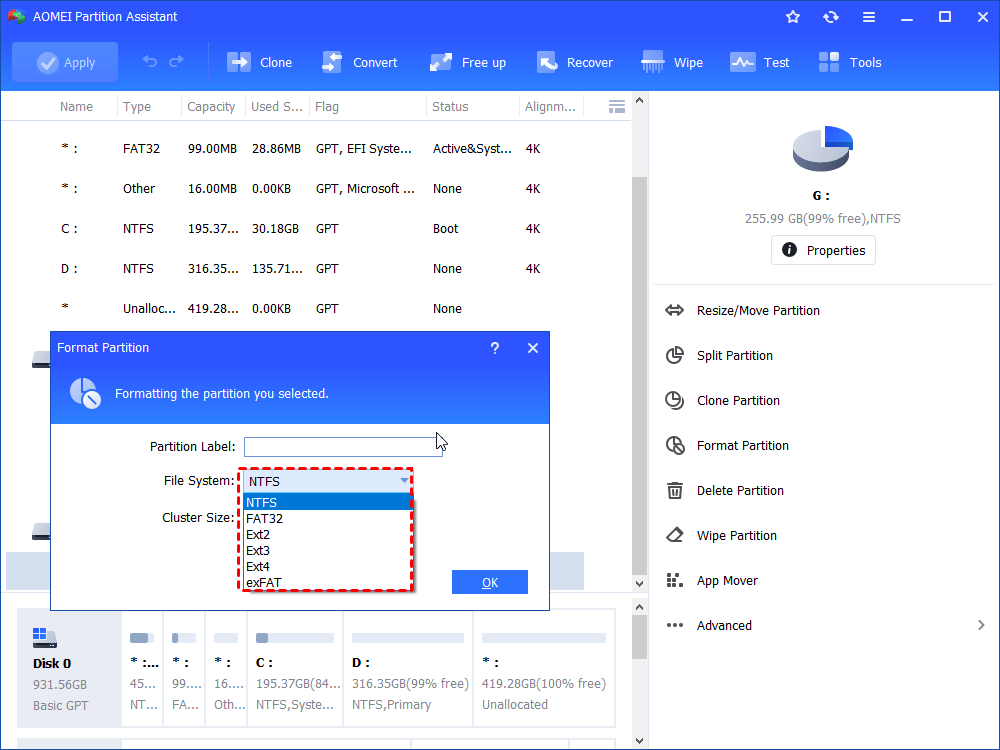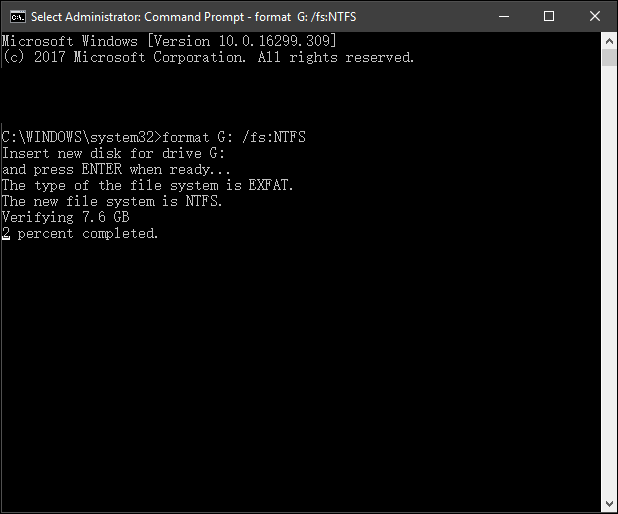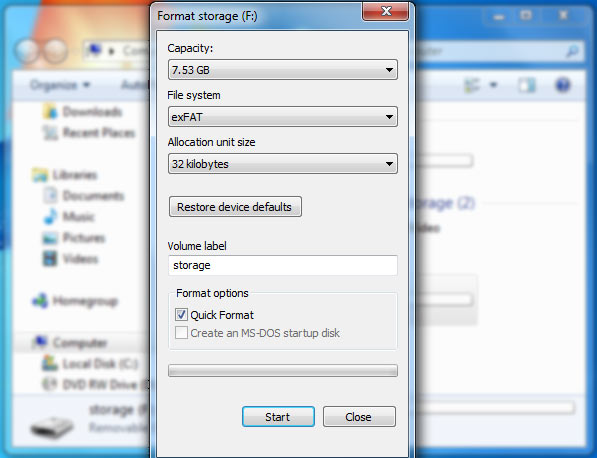While Mac OS X includes only read-only support for NTFS, Macs offer full read-write support for exFAT. ExFAT drives can be accessed on Linux by installing the appropriate software. While exFAT is compatible with Macs — and will be compatible with some devices that don’t support NTFS, like digital cameras — it still isn’t quite as. Like NTFS, exFAT can pre-allocate disk space for a file by just marking arbitrary space on disk as 'allocated'. For each file, exFAT uses two separate 64-bit length fields in the directory: the Valid Data Length (VDL) which indicates the real size of the file, and the physical data length.
Never trust ExFAT or anything aside from quick transfers. Ideally for long term storage LTO is the way to go but that has a pricey point of entry. For all my drives I use NTFS or Mac Journaled depending on the situation. If more Mac’s are gonna access it go Mac. If more PC’s, go NTFS. There’s software for both to get functionality anyway. Part 3: Bonus Tips to Convert “FAT32” to NTFS on Mac and Linux 1. Convert “FAT32” to “exFAT” on Mac. You can easily convert a “FAT32” file system to “exFAT” using the “Disk Utility” option on Mac. Follow the below steps for the following: Step 1: Go to “Applications”-” Utilities” and launch “Disk Utility”.
Whether you’re formatting an internal drive, external drive, USB flash drive, or SD card, Windows will give you the choice of NTFS, FAT32, and exFAT. The Format dialog in Windows doesn’t explain the difference, so we will.
FAT32 is an older file system that’s largely relegated to USB flash drives and other external drives. Windows uses NTFS for its system drive, and it’s also ideal for other internal drives. exFAT is a modern replacement for FAT32, and more devices support it than do NTFS — although it’s not as widespread as FAT32.
FAT32
This file system’s age has advantages and disadvantages. Because it’s so old, it’s the de-facto standard. Flash drives you purchase will often come formatted with FAT32 for maximum compatibility across not just modern computers, but other devices like game consoles and anything with a USB port.
Limitations come with that age, however. Individual files on a FAT32 drive can’t be over 4 GB in size — that’s the maximum. A FAT32 partition must also be less than 8 TB, which is less of a limitations — but still a noticeable one if you have a new, high-capacity mechanical drive.
While this file system is okay for USB flash drives and other external media, you won’t want to use this for an internal drive. It lacks the permissions and other security features built into the more modern NTFS file system. Modern versions of Windows can no longer be installed to FAT32, and must be installed onto drives formatted with NTFS.
Compatibility: Works with all versions of Windows, Mac, Linux, game consoles, and practically anything with a USB port.
Limits: 4 GB maximum file size, 8 TB maximum partition size.
Ideal Use: Use it on removable drives for maximum compatibility with the widest range of devices, assuming you don’t have any files 4 GB or larger in size.
NTFS
NTFS is the modern file system Windows likes to use. When you install Windows, it formats your system drive with the NTFS file system. NTFS has file size and partition size limits that are so theoretically huge you won’t run up against them. NTFS first appeared in consumer versions of Windows with Windows XP.
Aside from these limitations, NTFS is packed with other modern features. It supports file permissions for security, a change journal that can help quickly recover errors if your computer crashes, shadow copies for backups, encryption, disk quota limits, hard links, and other various features. Many of these are crucial for an operating system drive — especially file permissions.
Your Windows system partition must be NTFS. If you have a secondary drive alongside Windows and you plan on installing programs to it, you should probably go ahead and make it NTFS, too.
However, NTFS just isn’t as compatible with other operating systems. It’ll work with all recent versions of Windows — all the way back to Windows XP — but it has limited compatibility with other operating systems. By default, Mac OS X can only read NTFS drives, not write to them. Some Linux distributions may enable NTFS-writing support, but some may be read-only. None of Sony’s PlayStation consoles support NTFS. Even Microsoft’s own Xbox 360 can’t read NTFS drives, although the new Xbox One can. Other devices are even less likely to support NTFS.
Compatibility: Works with all versions of Windows, but read-only with Mac by default, and may be read-only by default with some Linux distributions. Other devices — with the exception of Microsoft’s Xbox One — probably won’t support NTFS.
Limits: No realistic file-size or partition size limits.
Ideal Use: Use it for your Windows system drive and other internal drives that will just be used with Windows.
exFAT
It’s a file system optimized for flash drives. It’s designed to be a lightweight file system like FAT32 without all NTFS’s extra features and overhead, but without FAT32’s limitations.
Like NTFS, exFAT has very large file size and partition size limits. This means you can store files that are larger than 4 GB apiece on a flash drive or SD card if it’s formatted with exFAT. exFAT is a strict upgrade over FAT32, and should be the best choice for external drives where you want a lightweight file system without FAT32’s file size limits.
exFAT is also more compatible than NTFS. While Mac OS X includes only read-only support for NTFS, Macs offer full read-write support for exFAT. exFAT drives can be accessed on Linux by installing the appropriate software.
While exFAT is compatible with Macs — and will be compatible with some devices that don’t support NTFS, like digital cameras — it still isn’t quite as compatible. Microsoft’s own Xbox 360 doesn’t support it, although the Xbox One does. The PlayStation 3 doesn’t support exFAT drives, although the PlayStation 4 reportedly does. Various other older devices may only support FAT32 instead of exFAT.
Compatibility: Works with all versions of Windows and modern versions of Mac OS X, but requires additional software on Linux. More devices support exFAT than support NTFS, but some — particularly older ones — may only support FAT32.
Limits: No realistic file-size or partition-size limits.
Ideal Use: Use it for USB flash drives and other external drives, especially if you need files of over 4 GB in size. Assuming every device you want to use the drive with supports exFAT, you should format your device with exFAT instead of FAT32.
NTFS is ideal for internal drives, while exFAT is generally ideal for flash drives. However, you may sometimes need to format an external drive with FAT32 if exFAT isn’t supported on a device you need to use it with.
CREDIT: HOWTOGEEK.COM
You might have heard about the terms of FAT32, NTFS or exFAT and need to decide which one to choose as the best file system for your SD card or USB flash stick. Don’t worry. In this article, we are going to introduce the three file systems so that you’ll know the difference between FAT32, NTFS and exFAT as well as their pros & cons and compatibility.
In order to avoid problems like slow USB transfer speed or “the file is too large for the destination file system”, it is necessary to know all the features and limitations of different file systems. For example, Windows operating system gets installed making the use of NTFS file system for partition formatting. In a similar way, FAT32 is used for files in removable disk drives and other such devices which have interface-based storage to keep the files. Basically, the exFAT file system is the modified derivation of FAT32. Keep looking if you need more information to differentiate FAT32, NTFS and exFAT files systems.
File System
While we are working with computer and other storage devices, all the workabilities are based on some kinds of algorithm and coding. There are some rules which are implemented to bring out that feature and function of every system. The file system is one of such sets of rules which are derived to process the data storage and keep it secured in a storage device. The computation system is brought in use to store the files in a secured manner.
File system surely is important to make the data stored with its value in the storage device. If it is not there, then only the undefined data will be stored in it. There are many types of file systems which can be used to store the files in different storage options or devices. They are Flash File System, Disk File System and many others. FAT32, NTFS and exFAT are the types of Disk File System.
How to format a USB stick to FAT32, NTFS or exFAT:

It is very easy to format a storage device to any of the three file systems on a Windows computer. Just right click on the disk drive in Windows File Explorer and choose Format, then you will get the options.
Allocation Unit Size
Allocation Unit Size, also known as Cluster Size is an important part of file systems. On a partition of the file, the smallest space occupied by it is termed as Allocation Unit Size. You can vary the file size as per your need ranging from 4096 to 2048K. At the time of formatting, the default allocation unit size is applied to all the files. The file is stored into the same number of pieces as its allocation unit.
Tips: Due to the mechanism of file systems, the data you deleted is not immediately removed from storage devices before new data is saved. Therefore, it is still possible to recover lost files from SD card, hard drive, USB flash stick or computer with a good data recovery software.
1. FAT32 File System
FAT stands for File Allocation Table which is one of the oldest file systems used for storage of data. Initially, it was designed as an 8-bit FAT file system to store the data into an 8-inch floppy disk.
With many modification and advancement, FAT32 was introduced in 1995. It is a great aid to store the files into the removable or external storage device or drives. Up to 4 GB of single file and a total of 8 TB as the maximum disk size for FAT32. So, it is used to store only the small files not the apps or files having a large size. To overcome this limitation of FAT32, NTFS is used.
Compatibility: All version of Windows, Mac, Linux, and almost anything with a USB port.
Pros:
- It is an amazing file system to store files in flash drives.
- It is lightweight and has cross-platform compatibility.
Cons:
- You can only store files having a size-limited up to 4 GB and partition size up to 8 TB.
2. NTFS File System
As we have already seen that FAT32 is not capable to store the large files. To nullify that limitation, NTFS is selected as the default file system with modern techniques to store the file with a large file and partition size.
NTFS or New Technology File System came into use in 1993 with the introduction of Windows NT 3.1 operating system. It is capable to store almost all types of files with a high range of file size limits. In other words, it is capable to store all types of files available at present.
NTFS is also featured with disk usage quotas, reparse points, sparse file support, file-level encryption and distributed link tracking. Moreover, it is also designed so as to display backward compatibility. That means, it is not limited to be used with any latest version. You can use this file system to store using any previous versions. However, this file system is somehow limited to Windows XP and later versions of Windows. You can only read the formatted files of NTFS using Apple’s Mac OSX. You can edit the file of NTFS using some particular versions of Linux.
Compatibility: All version of Windows, Microsoft Xbox One, Mac (read-only) and Linux (write support for some versions)
Pros:
- There is an inexhaustible limit of files to be stored using NTFS. You can store a file of any partition size.
- It is mainly used to store files in internal hard drives.
- It is used for the installation of software as well.
Cons:
Exfat Or Ntfs For Mac

- It is compatible with limited cross-platform.
- You can not edit the NTFS formatted file using Mac.
3. exFAT File System
exFAT or extended FAT is the modified and advanced file system which is used to fill the space of FAT32. It is mainly used in modern digital cameras and in ball games. Moreover, it is also used to format the high capacity SDXC memory cards. It is capable to support the formatting storage of large files and is lightweight as well. This is the reason why exFAT is considered in many fields where there is a need to support files larger than 4 GB. exFAT SD card is used in daily life for many purposes where the FAT32 is not capable to support due to its limitations of file size. You can copy a full HD movie easily using exFAT SD card and do many other such works.
At present, Microsoft is looking after the US Patent 8321439 which is developed for accelerating the file search speed. It is named as Quick Fine Make Lookup through which one can find his/her file by using Name hashtag or such keywords. This set of the specification has not yet brought up for the exFAT file system due to which this file system users are using a restricted licence over their files. They can get access to the file’s licence completely after the release of full specification set by Microsoft. Due to this, vendors from many countries are not using the exFAT file system for the open-source operating system or any commercial software.

Compatibility: Windows XP and later versions, Mac OS X and later versions, Linux (using FUSE), Android
Pros:
- It is lightweight as compared to NTFS.
- It is an intermediate solution over FAT32 and NTFS.
- You can read/write the exFAT formatted files using compatible Mac version as well.
- More devices support exFAT than NTFS.
Cons:
- Its usage is restricted by Microsoft and does not give complete access over the licence to the user.
Ntfs Or Exfat For Windows Mac And Linux
Verdict
Hence, you have seen all the basic and important features of these three file systems. Now, it will be easy for you to differentiate these file systems and select them appropriately for storing and formatting your files. Generally, exFAT is ideal for flash drives, NTFS for internal drives, and FAT32 is more widely supported by devices. However, in some cases, it is necessary to format a storage device as a file system against the regulation above in order to make the device work smoothly. If you have any queries related to these file systems, or whether you really need to safely remove USB, write it to us using the comments section.